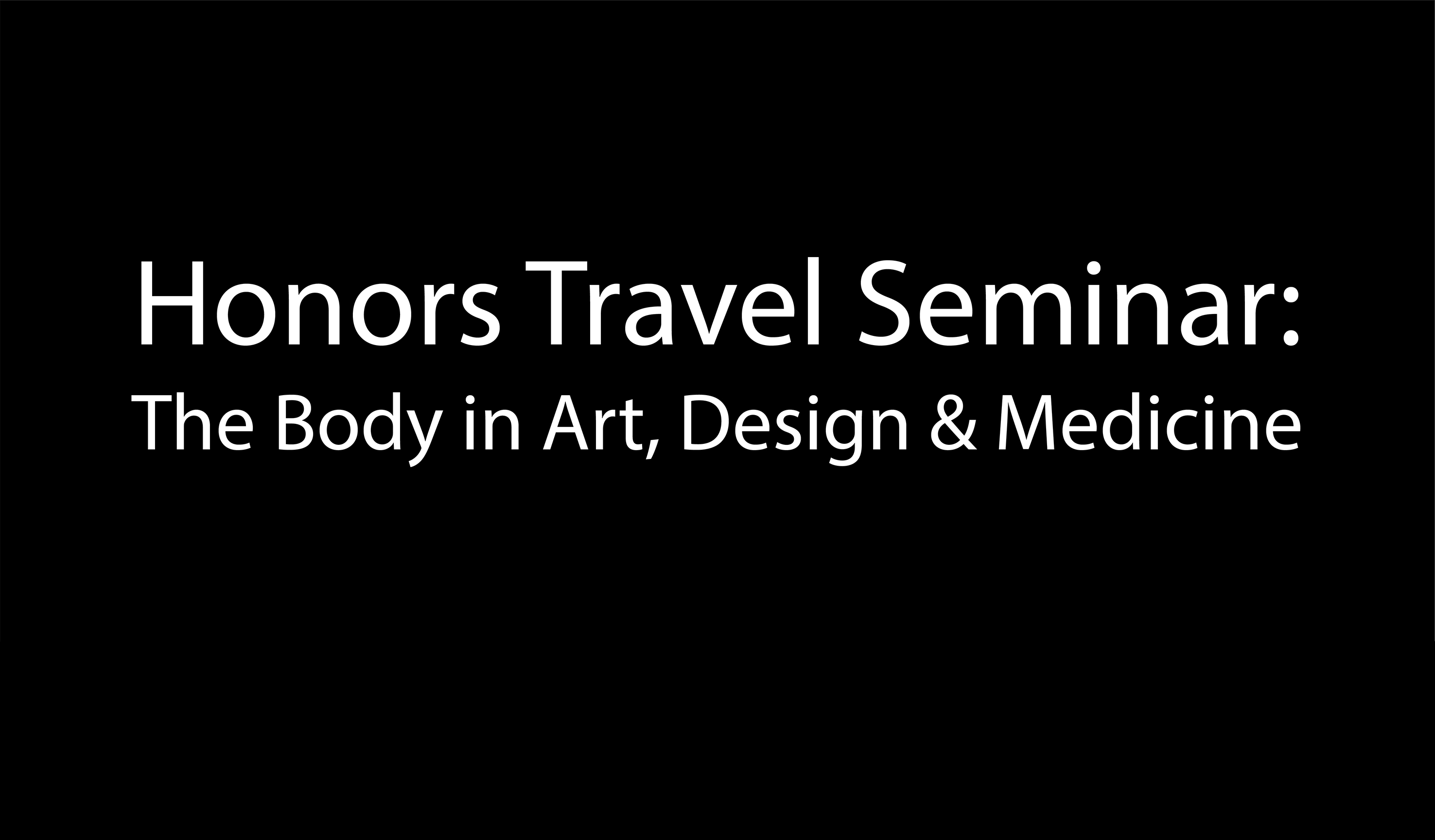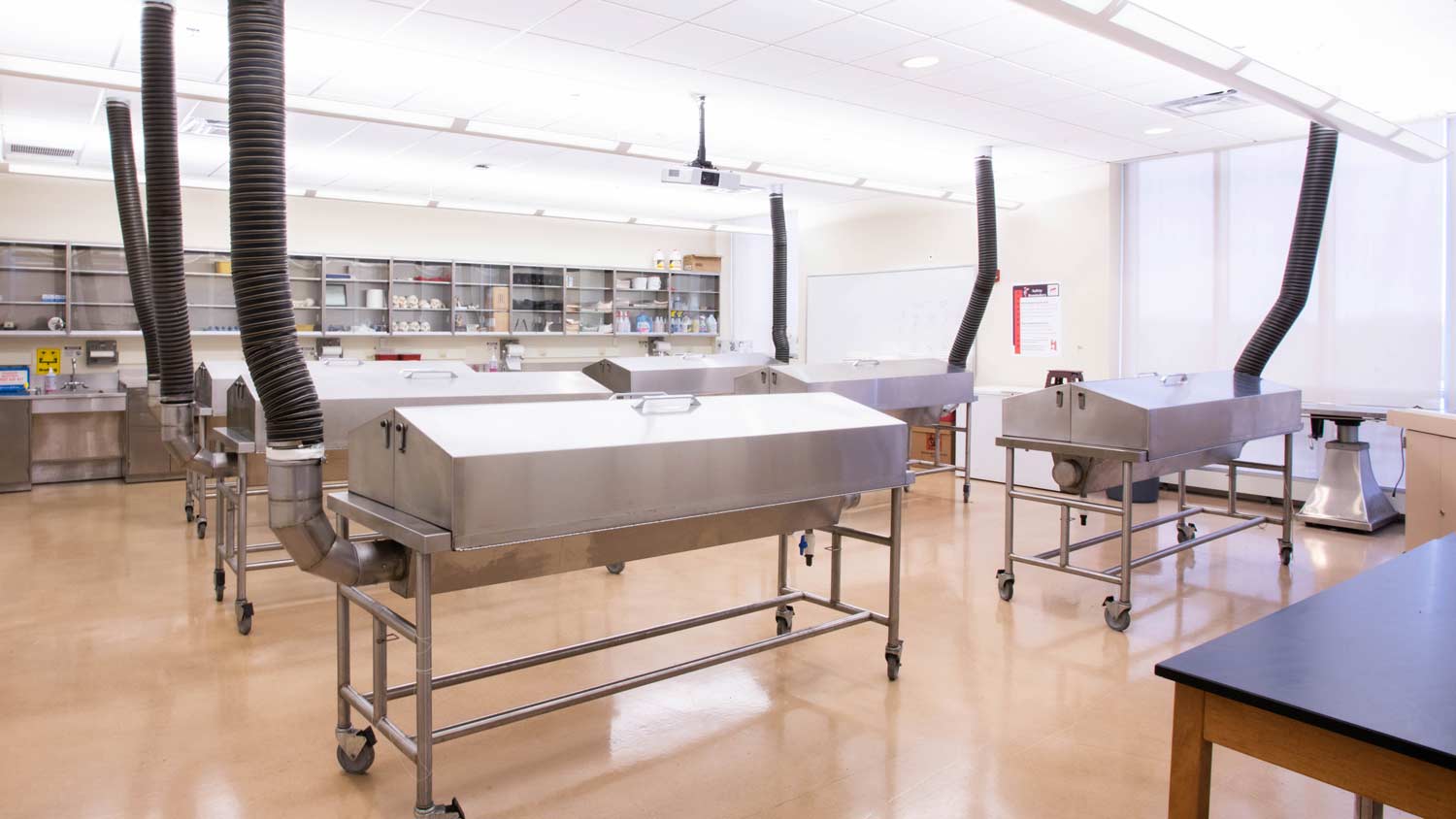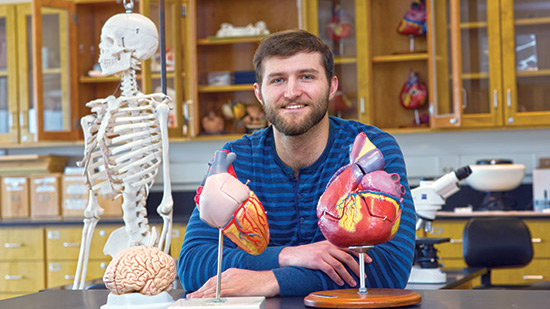Medical Illustration Master of Fine Arts Degree

Medical Illustration
Master of Fine Arts Degree
- RIT /
- Rochester Institute of Technology /
- Academics /
- Medical Illustration MFA
In RIT’s medical illustration degree you’ll become a highly skilled medical illustrator who can transform complex medical information into visual images that are used in education, research, patient care, public relations, legal cases, and health care marketing.
Overview for Medical Illustration MFA
Why Pursue an MFA in Medical Illustration at RIT
Perform complete cadaver dissections in RIT’s Cadaver Lab.
RIT's MFA program is one of five accredited graduate programs for medical illustration in North America by CAAHEP.
A medical illustrator is a professional artist with advanced education in the biomedical sciences, cutting edge digital media, and the principles of visual communication. RIT’s medical illustration degree combines training in human anatomy (with complete cadaver dissection in RIT’s Cadaver Lab), immunology, histology (the cellular structure of organs), and pathophysiology (the study of disease) with extensive training in 2D and 3D digital graphics, interactive media, and animation.
What is a Medical Illustrator?
Collaborating with scientists, physicians, and other health care professionals, medical illustrators translate complex scientific information into visual images that support medical education, science research, patient care, advertising, and litigation. Illustration projects are designed for use in print, projection, broadcast media, and distribution via the web and mobile devices.
RIT's Medical Illustration Degree
This is a two-year, graduate-level medical illustration degree where you’ll earn a master of fine arts (MFA). The program emphasizes visual problem solving to determine the best approach to communicate a difficult concept. Students also gain real world experience by collaborating with medical researchers and observing live surgery in operating rooms. The program culminates with the production of a thesis project, which requires extensive background research and an original body of artwork on a complex medical topic.
Becoming a Medical Illustrator
Successful medical illustrators must possess exceptional illustration skills and artistic ability while also having in depth knowledge of the biological sciences in order to fully understand and effectively communicate complex medical information. In the MFA in medical illustration degree, you'll accomplish the following outcomes:
Demonstrate an advanced level of knowledge in the biomedical sciences
- Demonstrate advanced knowledge of human anatomy, molecular biology, physiology, and related biomedical sciences
Visualize scientific structures, processes, and concepts
- Visualize and accurately render anatomic, tissue, cellular, and molecular structures
- Illustrate physiological processes and abstract scientific concepts through visual storytelling
List instructional objectives to communicate biomedical content to a variety of target learners
- Identify the target learners (audience) for each set of instructional illustrations
- Describe the level of scientific literacy of each group of target learners
- Create a set of instructional objectives for each instructional illustration
Solve complex communication problems with appropriate application of verbal and visual content, realism, symbolism, graphic conventions, and motion or interactive media.
- Select the most appropriate medium for delivery of content to target learners
- Select appropriate level of realism, symbolism, and graphic conventions for optimal delivery of instructional objectives to target learners
Utilize a variety of media and production techniques in appropriate applications and understand production processes sufficiently to communicate with pre-press companies, art directors, etc.
- Create artwork in a variety of media
- Select the appropriate dimensions, color space, resolution, file format, and other criteria for delivery to client
- Use industry standard terminology when discussing production and output processes
Communicate effectively with clients, subject matter experts, co-workers, supervisors, and vendors in oral and written form
- Use correct anatomic and medical terminology when discussing scientific content
Demonstrate knowledge of professional and ethical conduct
- Describe HIPAA regulations regarding the use of patient information
- Follow operating room protocols at affiliated hospitals
- Describe US and international copyright laws and how they apply to the use of reference materials
- Describe copyright infringement and the criteria for determining Fair Use
Demonstrate awareness of established business and management practices
- Describe standard employment practices in the profession
- Describe business models and taxation of independent illustrator
- Describe pricing strategies and calculate prices for illustration projects
- Create a personal identity package and marketing materials
- Generate sample contracts, licensing agreements, and invoices
Demonstrate competency in the academic research process through a graduate research project or thesis
- Conduct background research on a proposed biomedical topic
- Develop a set of instructional objectives to deliver the topic to a specific group of target learners
- Create a body of artwork to meet the instructional objectives
- Exhibit the body of work during one of the thesis shows or at a screening of digital media productions
- Complete a written thesis paper summarizing the project
Medical Illustrator Jobs
Graduates of RIT's medical illustration degree find employment with hospitals, medical schools, research centers, museums, medical publishers, advertising agencies, web design firms, animation studios, law firms, and a variety of other creative agencies. Since the MFA is considered the terminal degree in the arts, graduates may also teach in academic institutions or in a wide range of computer graphics, scientific illustration, or art programs. Organizations that employ our graduates include:
- Science magazine (American Association for the Advancement of Science)
- Department of Neurosurgery, University of North Carolina School of Medicine
- Department of Neurobiology and Anatomy, University of Rochester Medical Center
- New England Journal of Medicine
- Roswell Park Cancer Center, Buffalo, NY
- MIT Center for Biomedical Innovation
- OssoVR (virtual reality training for orthopedic surgery)
- Cell Press (publishers of Cell and other scientific journals)
- Nucleus Global (medical communications)
- Custom Learning Designs (pharmaceutical advertising)
- The Presentation Group (courtroom graphics)
- Emmi Solutions (web and interactive media)
- Cleveland Institute of Art (scientific illustration program)
- Illustrated Verdict (courtroom graphics)
- National Capital Area Medical Simulation Lab, Uniformed Services University of the Health Sciences (developing virtual surgical simulators)
- Visible Body/Argosy Medical Publishing (medical publishing and interactive media)
- Department of Imaging Sciences, University of Rochester Medical Center
- Smithsonian National Museum of Natural History
- Springer Healthcare Communications (medical publishing)
-
Join us for Fall 2025
Many programs accept applications on a rolling, space-available basis.
-
30% Tuition Scholarship for NY Residents and Graduates
Now is the perfect time to earn your Master’s degree. If you’re a New York state resident with a bachelor’s degree or have/will graduate from a college or university in New York state, you are eligible to receive a 30% tuition scholarship.
-
Next Steps to Enroll
Accept your offer of admission and take the next steps toward becoming an RIT Tiger.
Careers and Salary Info
Typical Job Titles
| Medical Illustrator | Medical Animator | Scientific Illustrator |
| Visual Information Specialist | VR/AR Designer | UI/UX Designer |
Featured Work and Profiles
-
Medical Illustration Senior Showcase - 2023
An online exhibition of work by 2023 medical illustration BFA seniors and MFA candidates.
Read More about Medical Illustration Senior Showcase - 2023 -
Honors Travel Seminar: The Body In Art, Design & Medicine
Student Work The Body in Art, Design and Medicine ITDI.300 The Body in Art, Design and Medicine will trace the history of documenting the human body from the perspective of anatomical correctness in art to the...
Read More about Honors Travel Seminar: The Body In Art, Design & Medicine
Curriculum for 2024-2025 for Medical Illustration MFA
Current Students: See Curriculum Requirements
Medical Illustration, MFA degree, typical course sequence
| Course | Sem. Cr. Hrs. | |
|---|---|---|
| First Year | ||
| ILLM-601 | Human Gross Anatomy |
6 |
This course provides an in-depth study of the structure of the human body. Emphasis is on understanding the relationships between anatomical structures as well as their form, texture, and color. Dissection of a human cadaver is supplemented with lectures on the structure and function of the major organ systems. (This course is restricted to ILLM-MFA Major students.) Lab 9, Lecture 3 (Fall). | ||
| ILLM-602 | Anatomic Studies |
3 |
Through independent research and acquired understanding of human gross anatomy, students create illustrations designed to support medical or graduate level instruction of Human Gross Anatomy. Course requires students to cognitively illustrate their subjects, rather than creating literal interpretations of their observations. Work is intended for full color print media. (This course is restricted to ILLM-MFA Major students.) Studio 5 (Fall). | ||
| ILLM-603 | 3D Modeling of Biomedical Forms |
3 |
This course introduces strategies to create polygonal models of biomedical subjects. Students will use contemporary research to accurately define structure and suggest function. Instruction will also focus on lighting and "shader" systems that emphasize form and are consistent with tissue characteristics. (This course is restricted to ILLM-MFA Major students.) Studio 6 (Fall). | ||
| ILLM-606 | 3D Animation of Biomedical Forms |
3 |
This course explores animating biomedical subjects and processes. Students will be asked to research contemporary theory defining their subjects' anatomy and create animations consistent with their findings. Frame by frame animation, blend shapes, non-linear deformers, and rigging systems will be introduced to permit students to choose the most effective method for creating motion and transformation. (Prerequisites: ILLM-603 or equivalent course.) Studio 6 (Spring). | ||
| ILLM-607 | Computer Applications in Medical Illustration |
3 |
Students will learn to use industry-standard raster and vector illustration software to create images based on independent research of medical topics. Students will also use page layout applications to combine digital images with text and other graphic elements. Coursework emphasizes creation of illustrations to support medical education and publishing. (This course is restricted to ILLM-MFA Major students.) Lecture 2, Studio 3 (Spring). | ||
| ILLM-608 | Scientific Visualization |
3 |
Emerging technologies enable scientists to visualize structures that are otherwise invisible to the naked eye. For example, molecular visualization software allows us to construct highly accurate molecular models from x-ray crystallography and other structural data. Cryo-EM and confocal microscopy are revealing the previously unknown structure of cellular organelles. Medical imaging systems allow us to reconstruct the human body in three dimensions from actual patient data (CT scans, MRI, etc.). This course explores the use of these technologies to provide references for traditional artwork and to export models for digital rendering and animation. (Prerequisites: ILLM-601 or equivalent course.) Studio 6 (Spring). | ||
| ILLM-890 | Thesis |
1 |
Students conduct background research and create a body of artwork on a contemporary medical topic. The artwork is exhibited during one of several graduate thesis shows or during a screening of digital animation and interactive works. The thesis culminates with the production of a written thesis paper that documents the process of creating the work. (This course is restricted to ILLM-MFA Major students.) Thesis (Fall, Spring). | ||
| MEDS-615 | Medical Pathophysiology |
3 |
This course is designed as a graduate-level course in pathophysiology, the study of disease and its consequences to human health. It covers mechanisms of cell injury, the homeostatic responses of cells and tissues, and the clinical manifestations of disease, concentrating on the disease states that are most frequently encountered in clinical practice, including infection, cancer, heart disease, and diabetes. The course follows a medical school model by using a clinical case-based approach that promotes active, team-based learning and professional written communication. Students will conduct independent research to create and illustrate a clinical case study. (This course is restricted to ILLM-MFA Major students.) Lecture 3 (Spring). | ||
| MEDS-630 | Human Immunology |
3 |
This graduate course in the Medical Illustration (MFA) program will provide an introduction to the fundamental facts and concepts on immunology to include: innate and adaptive immunity; cells, molecules, tissues and organs of the immune "system"; cell communication and interaction; antibody structure and function; and the application of these concepts to infectious diseases, vaccine design, autoimmune diseases, cancer, transplantation, regulation of the immune response, allergic reactions and immunosuppression. Students will gain an understanding of immunological principles and techniques, and their application to contemporary research, with results from instructor’s research laboratory. (This course is restricted to ILLM-MFA Major students.) Lecture 3 (Fall). | ||
Studio Elective |
3 | |
| Second Year | ||
| ILLM-612 | Surgical Illustration |
3 |
Students observe and sketch live surgical procedures at a local hospital. After further background research, students translate their sketches into finished illustrations that are used in medical training, patient education, and litigation. Demonstrations of sketching and rendering techniques are supplemented with lectures on general surgical principles and common procedures. (Prerequisites: ILLM-601 and ILLM-607 or equivalent courses.) Studio 6 (Fall). | ||
| ILLM-615 | Interactive Media I |
3 |
This course is an introduction to two dimensional computer illustration, animation, and interactive media as they apply to contemporary methods of instruction in medicine and allied health. Students will research a current topic in health care and develop interactive lessons that match the instructional objectives of their topic. Students will organize these lessons as a web site. (Prerequisites: ILLM-607 or equivalent course.) Lec/Lab 6 (Fall). | ||
| ILLM-616 | Interactive Media II |
3 |
This course continues the development of student web sites designed for allied health instruction. Advanced topics in two dimensional computer illustration, animation, and interactive media will be presented. Students will research current topics in health care and continue the development of the interactive lesson begun in the previous class. (Prerequisites: ILLM-615 or equivalent course.) Studio 6 (Spring). | ||
| ILLM-617 | Portfolio and Business Practices |
3 |
This course helps prepare students to enter the workforce in full-time positions or as freelance illustrators. Students create a traditional portfolio, personal identity package, and marketing materials. The course also introduces important business concepts such as copyright, licensing, pricing, contracts, taxation, and formation of a proper business. (Prerequisites: ILLM-612 or equivalent course.) Lab 3, Lecture 2 (Spring). | ||
| ILLM-890 | Thesis |
9 |
Students conduct background research and create a body of artwork on a contemporary medical topic. The artwork is exhibited during one of several graduate thesis shows or during a screening of digital animation and interactive works. The thesis culminates with the production of a written thesis paper that documents the process of creating the work. (This course is restricted to ILLM-MFA Major students.) Thesis (Fall, Spring). | ||
| MEDS-620 | Histology and Histopathology |
4 |
This graduate course in the Medical Illustration (MFA) program combines lecture and laboratory sessions to introduce students to the microscopic anatomy of both normal and pathologic human tissues and organs, with special emphasis given to the relationships between cellular architecture and normal versus altered physiologic function. Students will created illustrations and annotated digital images, and complete a final project designed to teach the etiology and pathogenesis of a chosen disease state to students at a graduate level. (One year of General Biology with lab) (This course is restricted to ILLM-MFA Major students.) Lab 3, Lecture 3 (Fall). | ||
Studio Elective |
3 | |
| Total Semester Credit Hours | 59 |
|
Studio Electives
| Course | ||
|---|---|---|
| HCIN-610 | Foundations of Human-Computer Interaction |
|
Human-computer interaction (HCI) is a field of study concerned with the design, evaluation and implementation of interactive computing systems for human use and with the study of major phenomena surrounding them. This course surveys the scope of issues and foundations of the HCI field: cognitive psychology, human factors, interaction styles, user analysis, task analysis, interaction design methods and techniques, and evaluation. This course will focus on the users and their tasks. (This class is restricted to degree-seeking graduate students or those with permission from instructor.) Lecture 3 (Fall, Spring). | ||
| HCIN-620 | Information and Interaction Design |
|
Designing meaningful relationships among people and the products they use is both an art and a science. This course will focus on the unique design practice of: representing and organizing information in such a way as to facilitate perception and understanding (information architecture); and, specifying the appropriate mechanisms for accessing and manipulating task information (interaction design). This course will also explore the various design patterns (design solutions to particular problems) that are appropriate for the HCI professional. Students will need prior knowledge of an interface prototyping tool. (Prerequisite: ISTE-200 or equivalent course.
Co-requisite: HCIN-610 or equivalent course.) Lecture 3 (Fall, Spring). | ||
| HCIN-660 | Fundamentals of Instructional Technology |
|
Instructional Technology encompasses the basic processes for developing and delivering instruction. Instructional Systems Design (ISD) is a well-established methodology for describing knowledge and skills and developing instructional systems to effectively conveying knowledge. This course enables the student to be able to plan, organize, and systematically develop instructional materials. The course uses an ISD model to analyze, design, deliver, and evaluate instruction. Lecture 3 (Fall). | ||
| ILLM-618 | Eye Ear and Nose Prosthetics |
|
This course provides an introduction to the field of anaplastology, a branch of medicine dealing with the prosthetic replacement or correction of an absent, disfigured, or malformed anatomic structure, usually on the face or limbs. Focusing on maxillofacial prosthetics and ocular prosthetics (artificial eyes), students learn the basic technical skills needed for an internship or apprenticeship in this field. **Fee: There is a $45 fee for this course** (Prerequisites: This course is restricted to ILLM-MFA students who have successfully completed ILLM-601 or equivalent course.) Lecture 2, Studio 3 (Spring). | ||
| ILLM-627 | Advanced Digital Technology for Medical Instruction |
|
Students will work with 3D modeling and animation software along with gaming engines to create interactive learning modules for medical and scientific applications that can be experienced through virtual reality, augmented reality, or mixed reality. Studio 6 (Spring). | ||
| ILLM-628 | Medical and Scientific Animation |
|
Students will work with 2 dimensional, 3 dimensional and editing software in order to develop a complete animation on the topic of their choice. Studio 6 (Fall). | ||
| ILLM-689 | Special Topics |
|
This course is an upper division course on a topic of special interest that is not part of a formal curriculum. The course design may differ by topic or faculty member but will include prerequisites, contact hours, and examination/assessment procedures. The level of study is appropriate for students in their final two years of study. (This course is restricted to ILLM-MFA Major students.) Lec/Lab (Fall, Spring). | ||
| ILLM-799 | Independent Study |
|
Medical Illustration Independent Study will provide students with the ability to study in a specialized area with an individual faculty member. Students, with the assistance of a faculty advisor will propose a course of study. Medical Illustration Independent Study students must obtain permission of an instructor and complete the Independent Study Permission Form to enroll. Ind Study (Fall, Spring, Summer). | ||
Any graduate studio course offered in the College of Art and Design |
||
Students are also interested in
Admissions and Financial Aid
This program is available on-campus only.
| Offered | Admit Term(s) | Application Deadline | STEM Designated |
|---|---|---|---|
| Full‑time | Fall | February 1 priority deadline, rolling thereafter | No |
| Part‑time | Fall | Rolling | No |
Full-time study is 9+ semester credit hours. Part-time study is 1‑8 semester credit hours. International students requiring a visa to study at the RIT Rochester campus must study full‑time.
Application Details
To be considered for admission to the Medical Illustration MFA program, candidates must fulfill the following requirements:
- Complete an online graduate application.
- Submit copies of official transcript(s) (in English) of all previously completed undergraduate and graduate course work, including any transfer credit earned.
- Hold a baccalaureate degree (or US equivalent) from an accredited university or college. A minimum cumulative GPA of 3.0 (or equivalent) is recommended.
- Satisfy prerequisite requirements and/or complete bridge courses prior to starting program coursework.
- Submit a current resume or curriculum vitae.
- Submit a personal statement of educational objectives.
- Submit two letters of recommendation.
- Entrance exam requirements: None
- Submit a portfolio. View portfolio requirements.
- Submit English language test scores (TOEFL, IELTS, PTE Academic), if required. Details are below.
English Language Test Scores
International applicants whose native language is not English must submit one of the following official English language test scores. Some international applicants may be considered for an English test requirement waiver.
| TOEFL | IELTS | PTE Academic |
|---|---|---|
| 79 | 6.5 | 56 |
International students below the minimum requirement may be considered for conditional admission. Deaf and hard-of-hearing test takers with significant hearing loss do not need to take the listening and speaking sections for the TOEFL and IELTS. Each program requires balanced sub-scores when determining an applicant’s need for additional English language courses.
How to Apply Start or Manage Your Application
Cost and Financial Aid
An RIT graduate degree is an investment with lifelong returns. Graduate tuition varies by degree, the number of credits taken per semester, and delivery method. View the general cost of attendance or estimate the cost of your graduate degree.
A combination of sources can help fund your graduate degree. Learn how to fund your degree
Additional Information
Prerequisites
Applicants must have one year of general or introductory biology (for biology majors), and a minimum of three advanced biology courses, such as vertebrate anatomy, physiology, neurobiology, cell biology, molecular biology, immunology, microbiology, genetics, developmental biology, or pathology.
Accreditation
RIT's MFA in medical illustration is one of five accredited graduate programs for medical illustration in North America. Programmatic accreditation by Commission on Accreditation of Allied Health Education Programs (CAAHEP) ensures the standards by which RIT's program is measured have been developed by professionals in our discipline. The rigorous process of CAAHEP accreditation as well as annual oversight ensures that our program meets or exceeds these industry standards.
Commission on Accreditation of Allied Health Education Programs
25400 U.S. Highway 19 North, Suite 158
Clearwater, FL 33763
Phone: 727-210-2350
Fax: 727-210-2354
Related News
-
August 5, 2024
![James Perkins posing on stage with two other men.]()
James Perkins receives prestigious Brödel Award at AMI Conference
James Perkins, a distinguished faculty member at RIT, has been awarded the Brödel Award for Excellence in Education by the Association of Medical Illustrators, recognizing his outstanding contributions to medical illustration education.
-
July 3, 2024
![a clipboard is shown holding a paper with an illustration of a human spine.]()
Medical Illustration Podcast - RIT program faculty interview
PK Visualization's Medical Illustration Podcast talks to Jim Perkins, Department Head of Medical Sciences, Health and Management, along with Glen Hintz and Craig Foster, both associate professors in the School of Art, about the origins of RIT's medical illustration program the accreditation process that made it a Master of Fine Arts program.
-
May 7, 2024
![a man stands next to a wall covered in comic book covers. On the right side of the wall there is a sign that says Kubert Lounge and Gallery.]()
Comics go to College
The comics collection at RIT is growing by leaps and bounds and the new Kubert Lounge and Gallery makes it a visible presence on campus. The interdisciplinary art form is right at home at RIT.
Contact
- Delaney Ball
- Assistant Director
- Office of Graduate and Part-Time Enrollment Services
- Enrollment Management
- 585‑475‑6933
- Delaney.Ball@rit.edu
- James Perkins
- Program Director of Graduate Medical Illustration
- Department of Medical Sciences, Health, and Management
- College of Health Sciences and Technology
- 585‑475‑2443
- japfaa@rit.edu






















